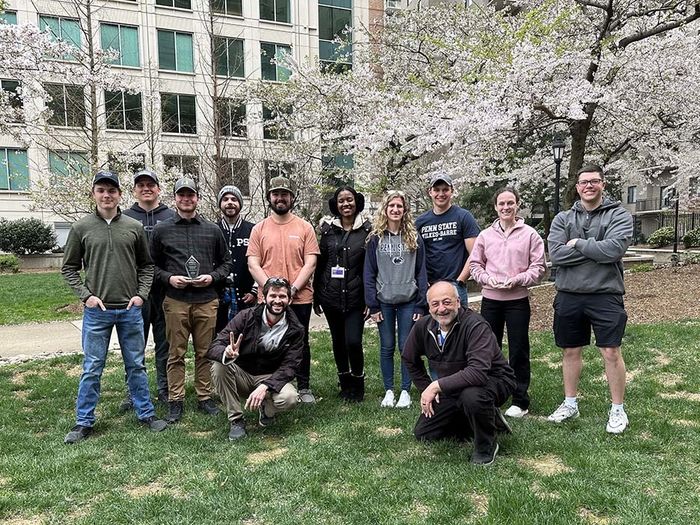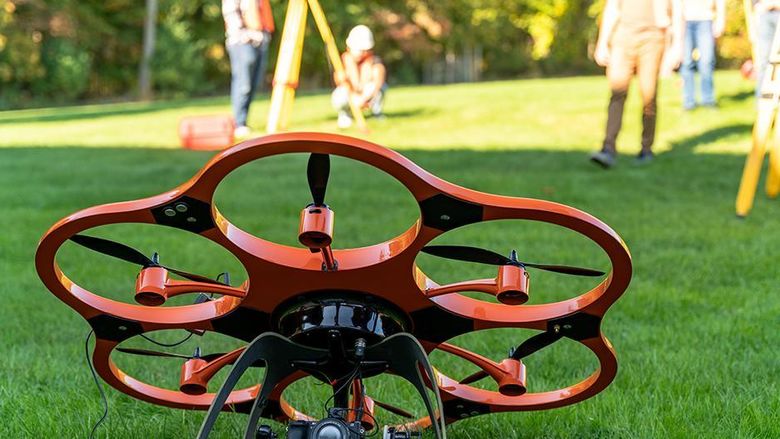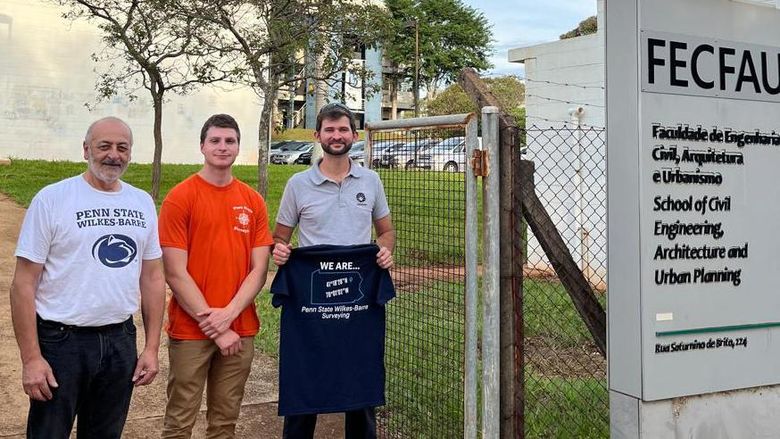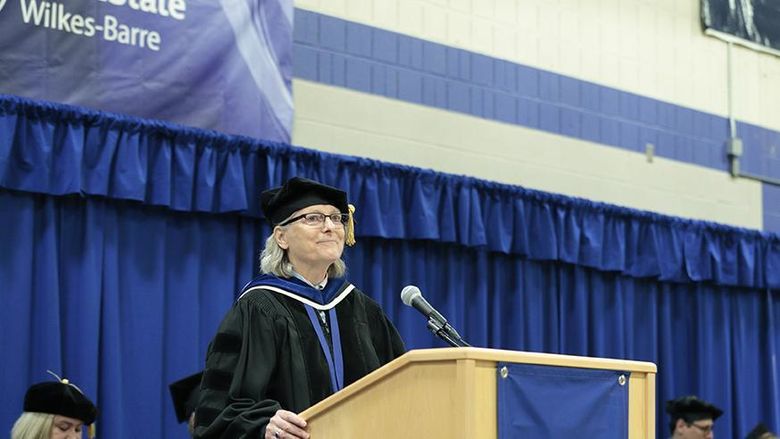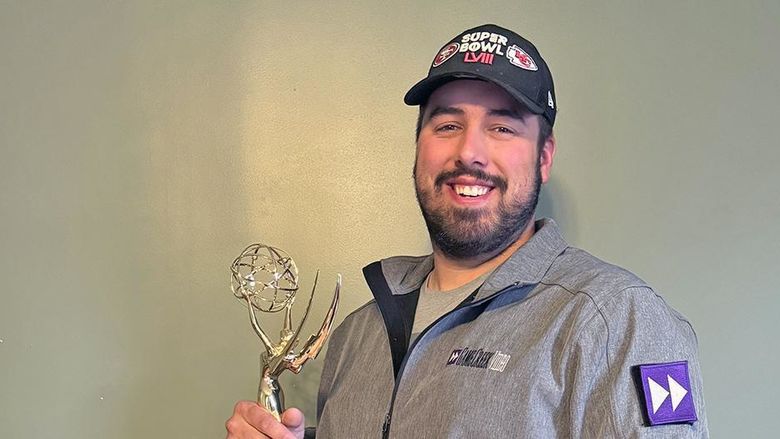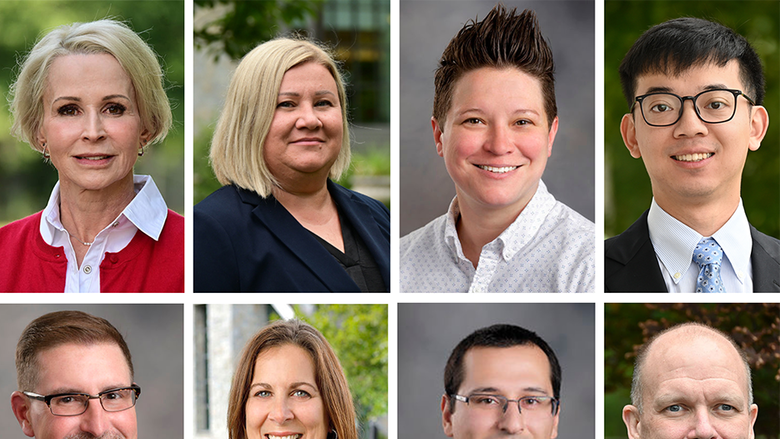
Students from the Penn State Wilkes-Barre Surveying Society use equipment during the National Society of Professional Surveyors’ Student Competition in Washington, D.C.
Note: The Penn State Wilkes-Barre Surveying Society participated in the National Society of Professional Surveyors’ Student Competition, held in Washington, D.C., receiving an honorable mention at the end of the competition. Nathan Crotts, a second-year student in the surveying engineering program, wrote about the students’ experience.
The Penn State Wilkes-Barre Surveying Society had a great week in Washington, D.C., at the National Society of Professional Surveyors (NSPS) Student Competition, held from March 28 to April 1. At the event, 24 teams competed from 17 states and one U.S. territory, with 21 academic programs making up the teams. The competition allowed us to use historic equipment along various sites throughout the city.
Our group from Penn State Wilkes-Barre included 10 students and two faculty members, Henrique Oliveira, assistant teaching professor of surveying engineering, and Salvatore Marsico, associate professor of surveying engineering. We had two teams of five students. I led one team and Hannah Corson, president of our campus Surveying Society, led the other.
When our Penn State Wilkes-Barre group arrived on the night of March 28, we went to a reception for all the teams to have a meet and greet. We were all able to familiarize ourselves with a 1950s T2 Theodolite, an 18th-century compass, and a Gunter's chain, a piece of distance measuring equipment. Each piece of equipment was going to be used on the second day of competition for Penn State and 10 other teams. Since there were 24 teams and limited space and resources, 12 of the teams started with the scavenger hunt and the other 12 started with the exercises.
Mackenzie Hixon, part of the group from Penn State Wilkes-Barre, said she enjoyed the competition and new means of learning.
“Traveling to Washington, D.C., with my Penn State Wilkes-Barre team to participate in the NSPS Competition was an exciting experience,” she said. “I worked collaboratively with my team to explore the city, locating monuments that dated back to the 1900s. We had the chance to compete against competitors from all over the country. The highlight of the trip for me, a true once-in-a-lifetime experience, was surveying the historical Washington Monument using vintage survey equipment.”
The first day for our team consisted of a six-hour scavenger hunt for major surveying monuments across Washington, D.C. Each team, along with a NSPS Young Surveyor (surveyors 35 or under, students of surveying or those surveyors within 10 years of graduating with a bachelor’s or master’s degree), strategized how to obtain the most points throughout the day. Monuments close to the National Mall had lower points than the major and farther monuments on the D.C. boundary line.
The NSPS provided every team member, adviser and Young Surveyor with a prepaid metro card. This allowed us to travel anywhere in D.C. On the morning of March 29, the 12 teams tasked with the scavenger hunt met by the entrance to the metro in the hotel where the main gatherings were located. Four teams were released every 15 minutes into the city.
The team I led, also known as PSU Team 2, decided to travel to the most northern boundary monuments of Washington, D.C., where we walked for 5-6 miles, collecting boundary monuments for points. We then traveled on the metro to the Federal Triangle to survey monuments and take a group photo as verification of our journey. We found monuments near government buildings, plaques and many memorials (the Thomas Jefferson, Martin Luther King Jr. and District of Columbia war memorials, to name a few).
Our journey ended around 2:30 p.m. after the team had walked 13 miles. We were also awarded extra points if we posted the group pictures we had collected throughout the day. I posted both teams' pictures in four collages on the Penn State Wilkes-Barre Surveying Society Instagram account. After the scavenger hunt, all 12 teams were exhausted from the long day walking in the sun as a surveyor would. The NSPS held a trivia event and reception that night, but as a group we had all decided to go to a Surveying Society group dinner with our advisers.
The second day consisted of three colonial surveying exercises: a triangulation, traverse and leveling loop. All of these exercises were completed on the National Mall next to the Washington Monument. The teams took turns on the exercises when equipment was available.
For PSU Team 2, we first began the triangulation, which is the procedure of finding the coordinates of an unknown point with three known coordinates and two measured angles. Our task was to use a T2 Theodolite to find our missing two angles, and then we were given an hour to calculate the unknown coordinate. This was an especially exciting exercise because the angles we measured were based off pointing at the uppermost tip of the Washington Monument and then to our unknown point. This gave us two small, measured angles and then we moved to our other position to collect the second angle. The procedure was the same, back-sight the Washington Monument and then rotate to the unknown point. We then worked to calculate the unknown coordinate.
After that, we walked to the traverse exercise, where we used a large golden 18th-century compass and a metal Gunter's chain, which is used to measure distances. We then measured angles and distances with the equipment and made calculations after our traverse. This exercise was exactly how colonial-era surveyors did their work. We then continued onto the leveling loop, which is the procedure of finding the precise elevation of point from a known elevation. This is a common procedure nowadays, so we were familiar with the task that we needed to do. We were given 45 minutes to complete the task and then an hour for calculations.
After the exercises were completed, we returned to the hotel for a reception and game night. Then on the morning of March 31, the Penn State students split up into two groups with one going to see the Smithsonian Museum and the other seeing the Arlington National Cemetery and White House. After that, every team and the NSPS state representatives met for an awards ceremony, where we received an honorable mention.
“I really enjoyed being a part of this competition. I liked seeing the different monuments and walking all over Washington, D.C., on the first day,” said Luke Jones, a sophomore at Penn State Wilkes-Barre. “Also, performing different surveying techniques using old equipment on the second day was very beneficial for me to learn.”
Lucas Carpenter, also in his second year at Penn State Wilkes-Barre, said, “When we got there on day one, I began talking to other students about their experience at the competition and immediately realized that the bond between students in the same profession is a strong one. We began talking about classes and programs that we are in, things we like and dislike and where we see ourselves going in the future. Some students were even kind enough to show me some tricks on the instruments we would be using because they wanted to see us succeed. By the end of three days, we began to get each other’s contact information for future events and questions. I am excited to go back and meet new people and catch up with old friends next year.”
